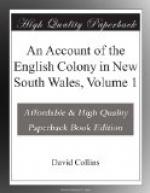The weather during the latter end of January and the month of February was very close, with rain, at times very heavy, and attended with much thunder and lightning. In the night of the 6th February, six sheep, two lambs, and one pig, belonging chiefly to the lieutenant-governor, having been placed at the foot of a large tree, were destroyed by the lightning. But accidents of this kind were rather to be expected than wondered at, until the woods around us could be opened and cleared.
CHAPTER II
Broken Bay visited
M. de la Perouse sails
Transactions
The Supply returns
Lord Howe Island discovered
The ships for China sail
Some convicts wounded by the natives
Scurvy
New store-house
Necessary orders and appointments
Excursions into the country
New branch of the harbour into Port Jackson
Sheep
March.] Early in March the governor, accompanied by some officers from the settlement and the Sirius, went round by water to the next adjoining harbour to the northward of this port, which is laid down in the charts by the name of Broken Bay, from the broken appearance of the land by which it is formed. The intention of this visit was, not only to survey the harbour, if any were found to exist, but to examine whether there were within it any spots of ground capable of cultivation, and of maintaining a few families; but in eight days that he was absent, though he found an harbour equal in magnitude to Port Jackson, the governor saw no situation that could at all vie with that which he had chosen for the settlement at Sydney Cove, the land at Broken Bay being in general very high and in most parts rocky and barren. The weather proved very unfavourable to an excursion in a country where the residence for each night was to be provided by the travellers themselves; and some of the party returned with dysenteric complaints. The weather at Port Jackson had been equally adverse to labour, the governor finding at his return upwards of two hundred patients under the surgeon’s care, in consequence of the heavy rains that had fallen. A building for the reception of the sick was now absolutely necessary, and one, eighty-four feet by twenty-three, was put in hand, to be divided into a dispensary, (all the hospital stores being at that time under tents,) a ward for the troops, and another for the convicts. It was to be built of wood, and the roof to be covered in with shingles, made from a species of fir that is found here. The heavy rains also pointed out the necessity of sheltering the detachment, and until barracks could be built, most of them covered their tents with thatch, or erected for themselves temporary clay huts. The barracks were begun early in March; but much difficulty was found in providing proper materials, the timber being in general shakey and rotten. They were to consist of four buildings, each building to be sixty-seven feet by twenty-two, and to contain one company. They were placed at a convenient distance asunder for the purpose of air and cleanliness, and with a space in the centre for a parade.




